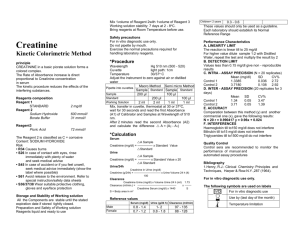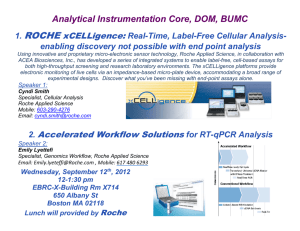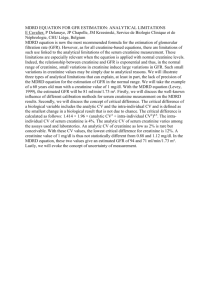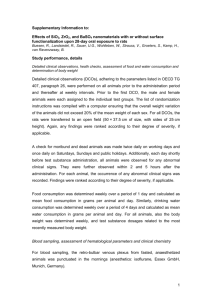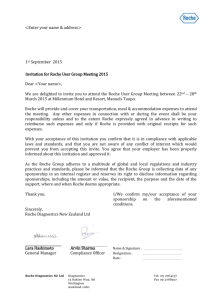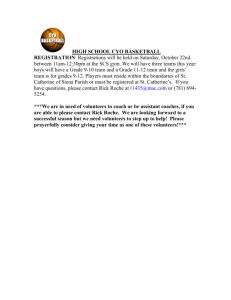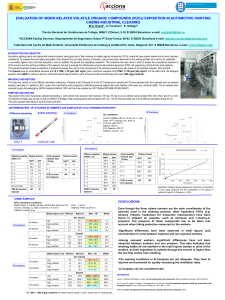Effective date for this procedure: January 3, 2004
advertisement
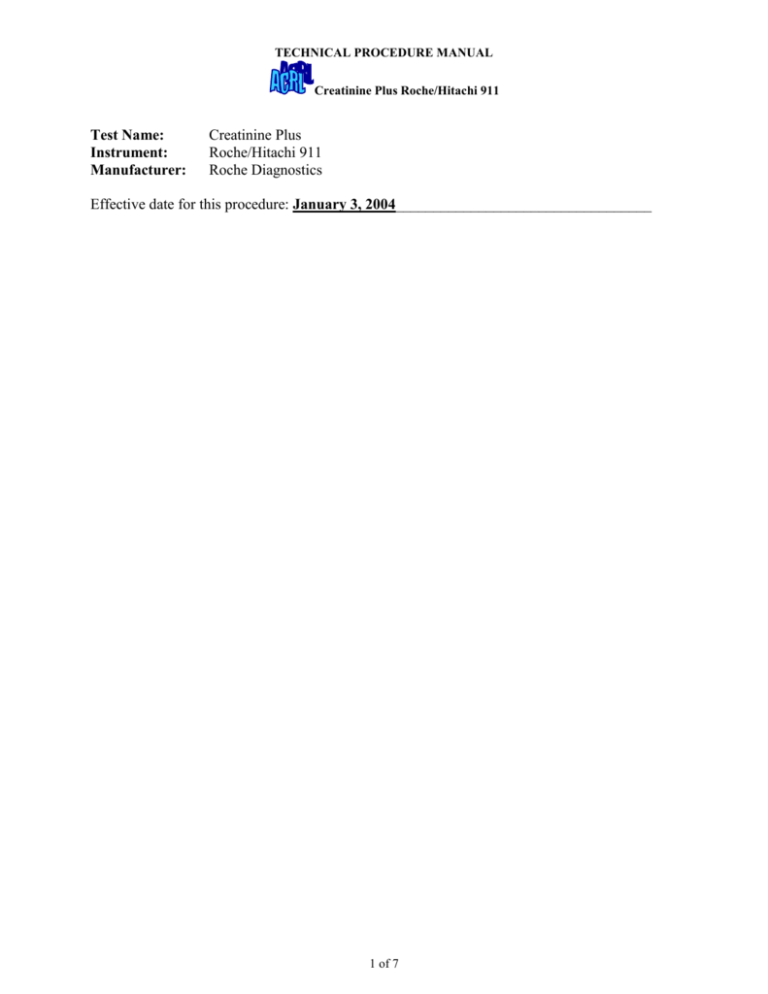
TECHNICAL PROCEDURE MANUAL Creatinine Plus Roche/Hitachi 911 Test Name: Instrument: Manufacturer: Creatinine Plus Roche/Hitachi 911 Roche Diagnostics Effective date for this procedure: January 3, 2004__________________________________ 1 of 7 TECHNICAL PROCEDURE MANUAL Creatinine Plus Roche/Hitachi 911 Intended Use Enzymatic in vitro assay for the direct quantitative determination of creatinine in human serum, plasma and urine using clinical chemistry analyzers. Please refer to your Package Insert or Operator's Manual for areas not completed. Summary Creatinine is produced endogenously from creatine and creatine phosphate as a result of muscle metabolic processes. It is excreted by glomerular filtration during normal renal function. Creatinine assays are conducted for diagnostic purposes, for therapeutic monitoring of acute and chronic renal diseases, and for monitoring kidney dialysis. The urinary creatinine concentration can also be used as a reference parameter for analyte excretion (albumin, α-amylase). Numerous methods have been described for determining creatinine, including the Jaffé alkaline picrate method in various modifications, as well as an enzymatic test which involves measuring ammonia after cleavage of creatinine by creatinine iminohydrolase. The enzymatic method is based on the established determination of sarcosine after conversion of creatinine with the aid of creatininase, creatinase, and sarcosine oxidase. The liberated hydrogen peroxide is measured via a modified Trinder reaction. Optimization of the buffer system and the colorimetric indicator enables the creatinine concentration to be quantified both precisely and specifically. Moreover, the results of this method correlate with those obtained by HPLC. Principle Enzymatic colorimetric assay Sample and addition of R1 (buffer/enzymes/HTIB) – Endogenous creatine is metabolized and lipemic sera are cleared of turbidity. Addition of R2 (buffer/enzymes/4-aminophenazone) and start of reaction: creatinine + H2O creatine + H2O creatininase creatinase sarcosine + H2O + O2 creatinine Creatininase hydrolyzes creatinine to creatine. sarcosine + urea Creatininase hydrolyzes creatinine to sarcosine. sarcosine oxidase glycine + HCHO + H2O2 Sarcosine is converted to glycine, formaldehyde, and hydrogen peroxide in the presence of oxygen by the action of sarcosine oxidase. H2 O2 +4-aminophenazone +HTIB peroxidase quinone imine chromogen +H2O +HI The liberated hydrogen peroxide reacts with 4-aminophenazone and HTIB to form a quinone imine chromogen. The reaction is catalyzed by peroxidase. The color intensity is directly proportional to the concentration of creatinine present and can be measured photometrically. Specimen Collection and Handling Universal Precautions apply. Collect serum using standard sampling tubes Plasma: The only acceptable anticoagulants are Li-heparin or Na-EDTA Stability: 7 days at 2 –8 °C, Freeze for long-term storage. Urine Stability: 4 days at 2 –8 °C, Freeze for long-term storage. Collect urine without using preservatives. Roche/Hitachi analyzers with automatic dilution 2 of 7 TECHNICAL PROCEDURE MANUAL Creatinine Plus Roche/Hitachi 911 Urine samples are diluted 1 +10 with distilled or deionized water, or 0.9%NaCl. This dilution is taken into account when the results are calculated. 3 of 7 TECHNICAL PROCEDURE MANUAL Creatinine Plus Roche/Hitachi 911 Roche/Hitachi analyzers without dilution Dilute urine samples manually 1 +10 with distilled or deionized water, or 0.9%NaCl. Multiply the result by 11. Samples containing precipitate must be centrifuged before performing the assay. If testing cannot occur immediately, laboratory protocol is: Store at -70ºC_________________________ Materials and Equipment Required Test Instrument: Roche/Hitachi 911 Materials Provided: Working solutions as described in the package insert. Additional Materials Required (but not provided): Calibrators and controls as indicated within the Calibration and Quality sections of this document. 0.9% NaCl General laboratory equipment Reagents R1 R2 TAPS buffer 30 mmol/l, pH 8.1;creatinase ≥ 20 kU/l (microorganisms); sarcosine oxidase ≥ 8 kU/l (microorganisms); ascorbate oxidase ≥ 2 kU/l (microorganisms); HTIB: 1.2 g/l; detergents; preservative TAPS buffer 50 mmol/l,pH 8.0; creatininase ≥ 30 kU/l (microorganisms); peroxidase ≥ 1 kU/l (horseradish); 4-aminophen-azone:0.4 g/l; potassium hexacyanoferrate (II):60 mg/l; detergent; preservative Storage and Stability Unopened kit components: Up to the expiration date at 2-8 °C R1: 28 days opened and refrigerated on the analyzer. R2: 28 days opened and refrigerated on the analyzer. Supplier(s) for the above materials: Roche___________________________________________________ ____________ Phone number of the supplier(s): 800-428-2336_____________________________________________ Calibration This test has been calibrated against HPLC. S1: 0.9% NaCl or distilled/deionized water S2: C.f.a.s. (Calibrator for automated systems), Cat. No. 10759350 (USA #759350) Calibration frequency – re-calibration is recommended. as blank calibration every 28 days as 2 point calibration after reagent lot change. as 2 point calibration as required following quality control procedures. Calibration verification: Not necessary. Refer to the appropriate calibration section of your Operator's Manual and/or the Package Insert for specific calibration instructions. 4 of 7 TECHNICAL PROCEDURE MANUAL Creatinine Plus Roche/Hitachi 911 Quality Control Serum/plasma For quality control, use Precinorm U, Precinorm U plus, Precipath U, Precipath U plus or other suitable control material. Urine For quality control use Precinorm Albumin, Precipath Albumin or other suitable control material. The control intervals and limits should be adapted to the individual laboratory requirements. Values obtained should fall within established limits. Each laboratory should establish corrective measures to be taken if values fall outside the limits. If controls do not recover within the specified limits, take the following corrective action. _See QA/QC Manuel for details_of corrective action________________________________________________ _____________________________________________________________________________________________ Refer to the appropriate value sheets/Package Insert for additional information. Preparation of Working Solutions R1: Ready for use R2: Ready for use Assay For optimal performance of this assay follow the directions given for the analyzer used. Refer to the appropriate operator’s manual and/or the Instrument Settings section of this insert for analyzer-specific assay instructions. The performance of applications not validated by Roche is not warranted and must be defined by the user. Interpretation: Reporting Results Refer to the Package Insert for expected values: Expected Values _______________________________________________________________________________ _______________________________________________________________________________ Critical Values _______________________________________________________________________________ _______________________________________________________________________________ Protocol to follow if critical value result is obtained: _Alert physician or study coordinator and document in the “Alert Log”.___________________ _________________________________________________________________________________ 5 of 7 TECHNICAL PROCEDURE MANUAL Creatinine Plus Roche/Hitachi 911 Precautions and Warnings For in vitro diagnostic use Exercise the normal precautions required for handling all laboratory reagents. Disposal of all waste material should be in accordance with local guidelines. Limitations — Interference Criterion: Recovery within ± 10% of initial values for creatinine concentrations of 1 mg/dl in serum and 100 mg/dl in urine. Serum/Plasma Icterus: No significant interference up to an I index of 25 (approximate conjugated and unconjugated bilirubin concentration: 25 mg/dl or 428 µmol/l). Hemolysis: No significant interference up to an H index of 1000 (approximate hemoglobin concentration:1000 mg/dl or 621 µmol/l). Lipemia (Intralipid):No significant interference up to an L index of 1000. There is a poor correlation between the L index (corresponds to turbidity)and triglycerides concentration. Ascorbic acid <300 mg/l does not interfere. Calcium dobesilate (e.g. Dexium) gives falsely low recoveries from 5 mg/l. N-ethylglycine and DL-proline at therapeutic concentrations give falsely high results. Cephalosporin antibiotics do not affect this test. Of 15 additional commonly used drugs tested in vitro, none interfered with the assay. Hemolyzed samples from neonates, infants or adults with HbF values ≥ 600 mg/dl interfere with the test. In very rare cases monoclonal gammopathy can lead to incorrect results. Urine Icterus: No significant interference up to an approximate conjugated bilirubin concentration of 70 mg/dl (1197 µmol/l). Hemolysis: No significant interference up to an approximate hemoglobin concentration of 1000 mg/dl (621 µmol/l). Ascorbic acid <300 mg/l,glucose <2000 mg/dl and urobilinogen <40 mg/dl do not interfere. Calcium dobesilate (e.g. Dexium) and α-methyldopa give falsely low recoveries. Of 10 additional commonly used drugs tested in vitro, none interfered with the assay. Performance Characteristics Refer to appropriate Package Insert. Contacts: Technical Support: Roche Response Center® Customer Technical Support: 1.800.428.2336 Service: Number to call for service: _Above___________________________ References Creatinine Plus Package Insert Roche Diagnostics Corporation 9115 Hague Rd. Indianapolis, IN 46256 P/N 1935976001 6 of 7 TECHNICAL PROCEDURE MANUAL Creatinine Plus Roche/Hitachi 911 Effective Date Effective date for this procedure: January 3, 2004_____________________________ Author Compiled by Roche Diagnostics Corporation Revised by: Charlie Rhodes_________________________________________________ Schedule for Review (See QA/QC SOP Manuals for Signatures) Last date revised: ____________________________________________ Date Reviewed:_____________ Approved:_______________________________ Date Reviewed:_____________ Approved:_______________________________ Date Reviewed:_____________ Approved:_______________________________ Date Reviewed:_____________ Approved:_______________________________ Date Reviewed:_____________ Approved:_______________________________ Date Reviewed:_____________ Approved:_______________________________ Date Reviewed:_____________ Approved:_______________________________ Date Reviewed:_____________ Approved:_______________________________ Date Reviewed:_____________ Approved:_______________________________ Date Reviewed:_____________ Approved:_______________________________ 7 of 7
